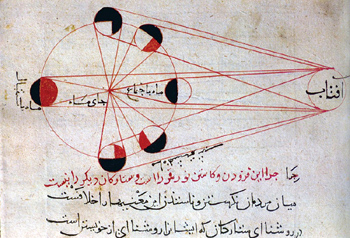
Al-Biruni's diagram of the moon's phases.
Credit: photo reproduction from Seyyed Hossein Nasr, Islamic Social Science: An Illustrated Study (World of Islam Festival Publishing Co., 1976).
Photo use for non-profit educational purposes only.
|
Ibn al-Shatir, whom we give credit for inventing the first modern sundial with gnomon pointing to the celestial pole in 1371 C.E., is but one of many scientific scholars of Central Asia during the “Eastern Renaissance” that lasted from about 800 to 1500 C.E. In this week’s issue of Science, [20 June 2014] Richard Stone reviews the accomplishments of Abu Rayhan al-Biruni (born 973 C.E.) and the possibility that he "discovered" the American continent.
Situated at the crossroads of cultures from China, India, the Middle East, and Europe, al-Biruni was an acomplished astronomer at an early age. At 16 he measured the height of the midday sun and calculated the latitude of his hometown, now in present day Khiva, Uzbekistan.
The Science article reviews work by S. Frederick Starr, chair of the Central-Asia-Caucasus Institute of Johns Hopkins School of Advanced International Studies: “[al-Biruni] traveled widely as an adult, and at a hilltop fortress near present-day Islamabad he devised a technique for measuring Earth's circumference using an astrolabe, spherical trigonometry, and the law of sines. (Like the ancient Greeks, Biruni was aware that Earth is round.) His calculation was a mere 16.8 kilometers off the modern value…”
“In a massive tome called the Masudic Canon completed in 1037 C.E., Biruni analyzed classical Greek, Indian, and Islamic astronomy and used ‘bold hypothesizing’ to sort out credible claims from fantasy, Starr says.” …. “Most sensational of all may be Biruni's ‘discovery’ of America. For the purpose of precisely determining the qiblah—the direction of Mecca during Islamic prayers—Biruni meticulously recorded coordinates of the places he visited, and compiled data on thousands of other Eurasian settlements from other sources. After plotting out the known world—possibly on a 5-meter-tall globe he is said to have constructed—he found that three-fifths of Earth's surface was unaccounted for … [al-Biruni] concluded that one or more landmasses must lie between Europe and Asia, writing, ‘There is nothing to prohibit the existence of inhabited lands.’”
